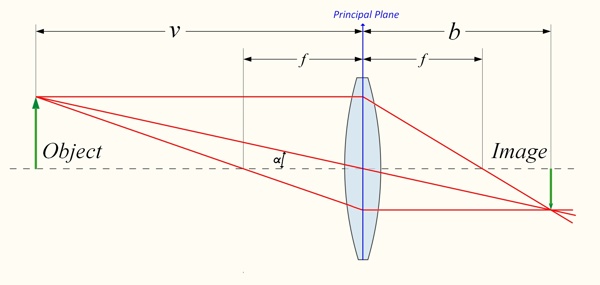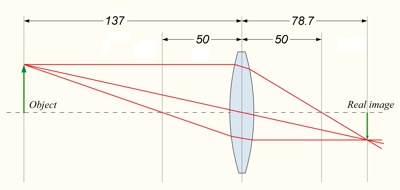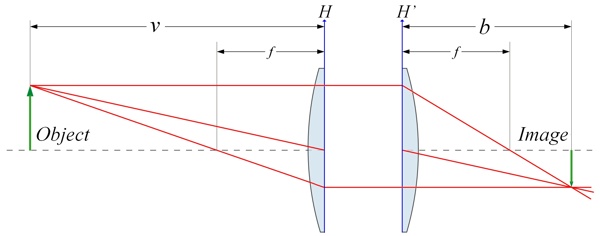 Originally posted by audiobomber
Originally posted by audiobomber 
This is where I disagree. I do not believe that any camera lens has a longer effective focal length (narrower FOV) at short distance than it does at long distance.
Welcome to the Twilight Zone. The rest of us live in a world with conventional optical physics. There is nothing revolutionary about the idea. Change of FOV with extension (aka focusing near with a non-internal focus lens) is a fact of life given that effective focal length (regular focal length too) is measured from the rear principle plane to the focal plane. FWIW, it also happens with a thin lens.
From the link I provided in a previous comment, below is the thin lens diagram:

Distance
b is the rear focus distance and
f is the nominal focal length. When focused to infinity,
b =
f and is equivalent to the focal length. The quoted text below describes what happens when focused to closer than infinity (lifted from the previously linked site (
LINK)).
 Quote:
Quote: For example, take a hypothetical 35mm camera lens, with only a single thin lens with a fixed focal length of 50mm. If you want to focus on objects at 'infinity', then the distance to the in-focus image on the film plane, b, becomes (b=1/(1/50-1/∞)), or 50mm, with a diagonal angle of view of 46.8° (on a full frame 35mm sensor).

Thin 50mm lens focused to 137mm from principal plane
 Quote:
Quote: But if you take the same fixed 50mm lens and want to focus it on a very close object, say at 137mm from the lens (v=137; seen above), then the distance to the in-focus image (the film plane), b becomes 78.7mm (b=1/(1/50-1/137)), with a diagonal angle of view of 30.7°. In other words, to focus the image of a close subject on the film plane, the lens needed to be moved 28.7mm further away from the film plane, which reduces the angle of view recorded by the photo by a third.
Note: There is a typo on the original article where "b" is printed instead of "v" when describing the distance from lens to subject. I corrected in the text above.
If one needs a concrete example, one may put the calculator away and put your camera to the eye. Frame a prominent vertical object (I used a fir tree) at say 200m distance at the edge of the frame with focus at infinity. Rotate the focus ring to MFD and watch that object disappear from the frame.
Below is the thick lens diagram. The front and rear principal planes are labeled
H and
H' respectively.

Internal focus works by moving the rear principle plane relative to the front principal plane rather than by moving the lens. As such the effective focal length as well as FOV changes according to the position of the rear principal plane. Move the plane back and FOV increases.
Why the thin lens formula does not properly calculate focal length at MFD is easy to see if one considers that focus distance is from the plane of focus (subject) to the focal plane and includes the distance between the front principal plane and rear principal planes. On a thin lens, the two are coincident and usually just referred to as "the principle plane". On a thick lens the distance between the two principal planes can be several centimeters depending on lens design. Using the thin lens formula also brings with it the assumption of symmetrical design. Most (all?) SLR lenses are asymmetrical* to some extent which complicates things. As a result Thom Hogan's famous formula will usually understate or overstate the rear focus distance depending on lens design.
In practice determining if a lens has deleterious focus breathing is easy enough by direct examination through the viewfinder. Alternative, a little logic will also work. One need not be virtually touching the subject in order to get 1:2.8 at 70mm (my Sigma 17-70). If one needs a quantitative measure for comparison purposes, it is much easier to simply measure the FOV at MFD directly as opposed to locating the principal plane locations and calculating the effective focal length.
Your project to actually do the FOV measurements should prove useful.
Steve
* The most common forms of asymmetry are true telephoto and retro-telephoto designs. True telephoto lenses place one or both principal planes forward of the front element to allow for compact design. Retro-telephoto (aka retrofocus) place the rear principal plane behind the lens rearmost element to allow for mirror clearance with short focal length lenses.


 Similar Threads
Similar Threads 













 Post #17 by stevebrot
Post #17 by stevebrot








